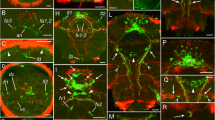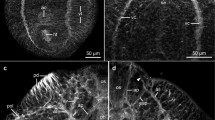Abstract
The organization of the nervous system of Archilopsis unipunctata Promonotus schultzei and Paramonotus hamatus (Monocelididae, Proseriata) and Stenostomum leucops (Catenulida) and Microstomum lineare (Macrostomida) was studied by immunocytochemistry, using antibodies to the authentic flatworm neuropeptide F (NPF) (Moniezia expansa). The organization of the nervous system of the Monocelididae was compared to that of the nervous system of Bothriomolus balticus (Otoplanidae), a previously studied species of another family of the Proseriata. The results show that the main nerve cords (MCs), independent of lateral or ventral position in the Monocelididae and the Otoplanidae, correspond to each other. The study also confirms the status of the lateral cords as main cords (MCs) in S. leucops and M. lineare. Common for MCs in the members of the investigated taxa are the following features: MCs consist of many fibres, originate from the brain and are adjoined to 5-HT-positive neurons. In Monocelididae and Otoplanidae, the MCs additionally have the same type of contact to the pharyngeal nervous system. Also common for both proseriate families is the organization of the two lateral nerve cords, with weaker connections to the brain, and the pair of dorsal cords running above the brain. The organization of the minor cords differs. The Monocelididae have a pair of thin ventral cords forming a mirror image of the dorsal pair. Furthermore, an unpaired ventral medial cord connecting medial commissural cells was observed in P. schultzei. Marginal nerve cords, observed in Otoplanidae, are absent in Monocelididae. All minor nerve cords are closely connected to the peripheral nerve plexus. The postulated trends of condensation of plexal fibres to cords and/or the flexibility of the peripheral nerve plexus are discussed. In addition, the immunoreactivity (IR) pattern of NPF was compared to the IR patterns of the neuropeptide RFamide and the indoleamine, 5-HT (serotonin). Significant differences between the distribution of IR to NPF and to 5-HT occur. 5-HT-IR dominates in the submuscular and subepidermal plexuses. In the stomatogastric plexus of M. lineare, only peptidergic IR is observed in the intestinal nerve net. The distribution of NPF-IR in fibres and cells of the intestinal wall in M. lineare indicates a regulatory function for this peptide in the gut, while a relationship with ciliary and muscular locomotion is suggested for the 5-HT-IR occurring in the subepidermal and submuscular nerve, plexuses. In M. lineare, the study revealed an NPF- and RFamide-positive cell pair, marking the finished development of new zooids. This finding indicates that constancy of these cells is maintained in this asexually reproducing and regenerating species.
Similar content being viewed by others
References
Ax P (1956) Monographie der Otoplanidae (Turbellaria), Morphologie und Systematik. Acad Wiss Lit Mainz, Abh Mat.-Naturw Kl 13:1–298
Brownlee DJA, Fairweather I, Johnston CF, Shaw C (1994) Immunocytochemical demonstration of peptidergic and serotoninergic components in the enteric nervous system of the roundworm, Ascaris suum (Nematoda, Ascaroidea). Parasitology 108:89–103
Coons AH, Leduc EH, Conolly JM (1955) Studies on antibody production I. A method for the histochemical demonstration of specific antibody and its application to a study of the hyperimmune rabbit. J Exp Med 102:49–60
Curry WJ, Shaw C, Johnston CF, Thim L, Buchanan KD (1992) Neuropeptide F: Primary structure from the turbellarian, Artioposthia triangulata. Comp Biochem Physiol 101:269–274
Ehlers U (1985) Das Phylogenetische System des Plathelminthss. Gustav Fischer, Stuttgart, New York
Falkmer S, El-Salhy M, Titlbach M (1984) Evolution of the endocrine system in vertebrates. A review with particular reference to the phylogeny and postnatal maturation of the islet parenchyma. In: Falkmer S, Håkanson R, Sundler F (eds) Evolution and tumor pathology of the neuroendocrine system. Elsevier Science Publishers, Amsterdam, pp 59–87
Grahn M, Maule AG, Elo I, Shaw C, Reuter M, Halton DW (1995) Antigenicity to neuropeptide F (NPF) in Stenostomum leucops and Microstomum lineare. Hydrobiologia (in press)
Gustafsson MKS, Halton DW, Maule AG, Reuter M, Shaw C (1994) The gull tapeworm, Diphyllobothrium dendriticum and neuropeptide F: an immunocytochemical study. Parasitology 109:599–609
Gustafsson MKS, Fagerholm H-P, Halton DV, Hanzelova V, Maule AG, Reuter M, Shaw C (1995) Neuropeptides and serotonin in the cestode, Proteocephalus exiguus: an immunocytochemical study. Int J Parasitol (in press)
Halton DW, Shaw C, Maule AG, Johnston CF, Fairweather I (1992) Peptidergic messengers: A new perspective of the nervous system of parasitic platyhelminths. J Parasitol 78:179–193
Hauser M, Koopowitz H (1987) Age-dependent changes in fluorescent neurons in the brain of Notoplana acticola, a polycladid flatworm. J Exp Zool 241:217–225
Hrčková G, Halton DW, Maule AG, Brennan GP, Shaw C, Johnston CF (1993) Neuropeptide F-immunoreactivity in the tetrathyridium of Mesocestoides corti (Cestoda, Cyclophyllidea). Parasitol Res 79:690–695
Joffe BI, Kotikova EA (1991) Distribution of catecholamines in turbellarians (with discussion of neuronal homologies in the Platyhelminthes). Stud Neurosci 13:77–113
Joffe BI, Reuter M (1993) The nervous system of Bothriomolus balticus (Proseriata) — a contribution to the knowledge of the orthogon in the Plathelminthes. Zoomorphology 113:113–127
Kabotyanski EA, Nezlin LP, Sakharov DA (1991) Serotonin neurons in planarian pharynx. Stud Neurosci 13:138–152
Keenan CL, Coss R, Koopowitz H (1981) Cytoarchitecture of primitive brains: Golgi studies in flatworms. J Comp Neurol 188:647–679
Koopowitz H (1986) On the evolution of the central nervous systems: Implications from polyclad turbellarian neurobiology. Hydrobiologia 132:79–87
Koopowitz H, Elvin M, Bae T (1995) Comparison of the nervous system of the rhabdocoel, Mesostoma ehrenbergii with that of the polyclad Notoplana acticola. Hydrobiologia (in press)
Kotikova EA (1976) Some features of the nervous system in Proseriate (Turbellaria) (in Russian). Zool Zh 54:508–514
Kotikova EA (1986) Comparative characterization of the nervous system of the Turbellaria. Hydrobiologia 132:89–92
Kotikova EA (1991) The orthogon of the Plathelminthes and main trends of its evolution (in Russian). Proc Zool Inst St Petersburg 241:88–111
Kotikova EA (1995) Glyoxylic-acid-induced-fluorescence in the nervous system of Gyratrix hermaphroditus (Kalyptorynchia, Polycystididae). Hydrobiologia (in press)
Krajniak KG, Greenberg MJ (1992) The localization of FMRFamide in the nervous and somatic tissues of Nereis virens and its effects upon the isolated esophagus. Comp Biochem Physiol 101C:93–100
Krajniak KG, Greenberg MJ, Price DA, Doble KE, Lee TD (1989) The identification, localization, and pharmacology of FMRF-amide-related peptides and SCPB in the penis and crop of the terrestrial slug, Limax maximus. Comp Biochem Physiol 94C:485–492
Krieger DT (1983) Brain peptides: what, where and why? Science 222:975–985
Lehman HK, Greenberg MJ (1987) The actions of FMRFamide-like peptides on visceral and somatic muscles of the snail Helix aspersa. J Exp Biol 131:55–68
Luther A (1960) Die Turbellarien Ostfennoskandiens I. Acoela, Catenulida, Macrostomida, Lecithoepitheliata, Prolecithophora, und Proseriata. Fauna Fenn 7:1–155
Mansour TE (1984) Serotonin receptors in parasitic worms. Adv Parasitol 3:1–36
Marks NJ, Maule AG, Halton DW, Shaw C, Johnston CF (1993) Distribution and immunochemical characterization of neuropeptide F (NPF) (Moniezia expansa)-immunoreactivity in Proteocephalus pollanicola (Cestoda: Proteocephalidea). Comp Biochem Physiol 104C:381–386
Maule AG, Shaw C, Halton DW, Thim L, Johnston CF, Fairweather I, Buchanan KD (1991) Neuropeptide F: a novel parasitic flatworm regulatory peptide from Moniezia expansa (Cestoda: Cyclophyllidea). Parasitology 102:309–316
Maule AG, Shaw C, Halton DW, Brennan GP, Johnston CF, Moore S (1992a) Neuropeptide F (Moniezia expansa): localization and characterization using specific antisera. Parasitology 105:505–512
Maule AG, Brenman GP, Halton DW, Shaw C, Johnston F, Moore S (1992b) Neuropeptide F-immunoreactivity in the monogenean parasite Diclidophora merlangi. Parasitol Res 78:655–660
Maule AG, Halton DW, Shaw C (1995) Neuropeptide F: A ubiquitous invertebrate neuromediator? Hydrobiologia (in press)
Palmberg I, Reuter M (1990) Neuronal subsets in regenerating Microstomum lineare. — Immunocytochemistry of FMRF/RF-amide and 5-HT. Acta Acad Abo Ser B 50(7):147–159
Rajpara SM, Garcia PD, Roberts R, Eliassen JC, OWens, DF, Maltby D, Myers RM, Mayeri E (1992) Identification and molecular cloning of a neuropeptide Y homolog that produces prolonged inhibition in Aplysia neurons. Neuron 9:505–513
Reisinger E (1925) Untersuchungen am Nervensystem von Bothrioplana semperi Braun. Z Morphol Ökol Tiere 5:119–149
Reisinger E (1972) Die Evolution des Orthogon der Spiralier und das Archicölomatenproblem. Z Zool Syst Evolutionsforsch 10:1–43
Reuter M (1988) Development and organization of the nervous system visualized by immunocytochemistry in three flatworm species. Prog Zool 36:181–184
Reuter M (1994) Substance P immunoreactivity in sensory structures and the central and pharyngeal nervous system of Stenostomum leucops (Catenulida) and Microstomum lineare (Macrostomida). Cell Tissue Res 276:173–180
Reuter M, Eriksson K (1991) Catecholamines demonstrated by glyoxylic-acid induced fluorescence and HPLC in some microturbellarians. Hydrobiologia 227:209–219
Reuter M, Gustafsson M (1995) The flatworm nervous system-pattern and phylogeny. In: Breidbach O, Kutsch W (eds) The nervous systems of invertebrates: an evolutionary and comparative approach. Advances in Life Sciences, Birkhäuser Company, Basel pp 25–59
Reuter M, Kuusisto A (1992) Growth factors in asexually reproducing Catenulida and Macrostomida (Plathelminthes)? A confocal, immunocytochemical and experimental study. Zoomorphology 112:155–166
Reuter M, Palmberg I (1987) An ultrastructural and immunocytochemical study of gastrodermal cell types in Microstomum lineare (Turbellaria, Macrostomida). Acta Zool (Stockholm) 68:153–163
Reuter M, Palmberg I (1989) Development and differentiation of neuronal subsets in asexually reproducing Microstomum lineare. Immunocytochemistry of 5-HT, RF-amide and SCPB. Histochemistry 91:123–131
Reuter M, Wikgren M, Palmberg I (1980) The nervous system of Microstomum lineare (Turbellaria, Macrostomida) I. A fluorescen and electron microscopic study. Cell Tissue Res 211:31–40
Reuter M, Karhi T, Schot LPC (1984) Immunocytochemical demonstration of peptidergic neurons in the central and peripheral nervous systems of the flatworm Microstomum lineare with antiserum to FMRF-amide. Cell Tissue Res 238:431–436
Reuter M, Wikgren M, Lehtonen M (1986) Immunocytochemical demonstration of 5-HT-like and FMRF-amide-like substances in whole mounts of Microstomum lineare (Turbellaria). Cell Tissue Res 246:7–12
Sakharov DA (1990) Integrative function of serotonin common to distantly related invertebrate animals. Acta Acad Abo Ser B 50(7):73–88
Sakharov DA, Golubev AI, Malyutina LV, Kabotyanski EA, Nezlin LP (1988) Serotoninergic control of ciliary locomotion in a turbellarian flatworm. In: Salanki J, Rózsa KS (eds) Neurobiology of invertebrates: transmitters, modulators and receptors. Budapest, Akadémiai Kiadó, pp 479–491
Wikgren M, Reuter M (1985) Neuropeptides in a microturbellarian — Whole mount immunocytochemistry. Peptides 6:471–475
Wikgren MC, Thorndyke MC (1990) An echinoderm neuropeptide in flatworms? Acta Acad Abo Ser B 50(7):45–52
Wikgren M, Reuter M, Gustafsson MKS, Lindroos P (1990) Immunocytochemical localization of histamine in flatworms. Cell Tissue Res 260:479–484
Author information
Authors and Affiliations
Rights and permissions
About this article
Cite this article
Reuter, M., Maule, A.G., Halton, D.W. et al. The organization of the nervous system in Plathelminthes. The neuropeptide F-immunoreactive pattern in Catenulida, Macrostomida, Proseriata. Zoomorphology 115, 83–97 (1995). https://doi.org/10.1007/BF00403257
Accepted:
Issue Date:
DOI: https://doi.org/10.1007/BF00403257




